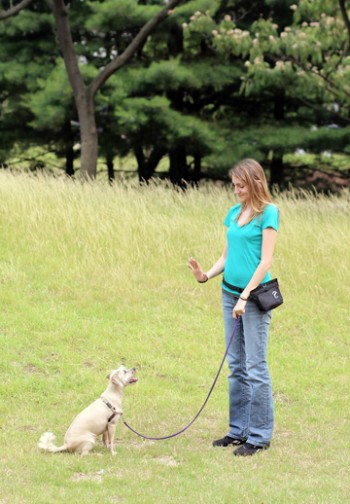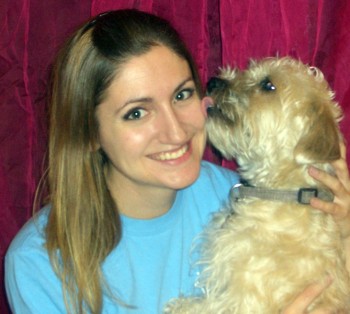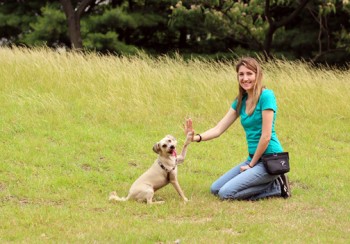Clare Mills teaches English in Cheonan and volunteers at the Jane World [3] shelter in Asan. When two mixed-breed puppies were found on the grounds of her school—just 10 days old and suffering from hypothermia—she took them home and nursed them back to health.
Small Puppy flew to the United States for adoption and settled in right away. Big Puppy [4] grew bigger and tore up Mills’ apartment.
“He ate a huge hole in my couch,” she says.
She loved the dog and would gladly have adopted him, but as a South African she was already facing an enormous bill to fly her own dog home at the end of her contract. She was terrified she wouldn’t be able to find a new home for Big Puppy in time, and her fears escalated after two failed adoptions.
“What if it goes wrong again?” she asked herself.
 One weekend Mills brought Big Puppy to Anyang in a crate—a two-hour trip by train, subway and taxi. They spent the next two hours working with internationally certified dog trainer Karolina Kaminski [5] in her apartment. Mills describes Kaminski as “very good with people,” as well as dogs, and says the session gave her confidence to keep promoting Big Puppy.
One weekend Mills brought Big Puppy to Anyang in a crate—a two-hour trip by train, subway and taxi. They spent the next two hours working with internationally certified dog trainer Karolina Kaminski [5] in her apartment. Mills describes Kaminski as “very good with people,” as well as dogs, and says the session gave her confidence to keep promoting Big Puppy.
“It was incredible watching what he could do,” Mills says. She also appreciated Kaminski’s encouragement as she learned to use hand signals.
“I think I learned more than Big Puppy did.”
After his adoption a month later, Mills received a message from Big Puppy’s adopter calling him “possibly the best-behaved puppy I’ve ever met.”
“[Kaminski] showed me that he’s not a lost cause,” Mills says, “and that he has a high attention span for a puppy his age.”
Instead of charging a fee, Kaminski asked Mills to donate 70,000 won to a fundraiser of her choice among those featured on Animal Rescue Korea. Mills decided on Bear [6], a foster dog whose rescuers needed help flying him to his new home in the United States.
“She took two hours out of her Sunday and didn’t pocket a cent,” Mills remarks.
Why Korea?
Kaminski lived in New York City for three years before coming to Korea in October, and she held several training positions there. Seven months before she moved overseas, she started the best job she’d ever had—with the prestigious Andrea Arden [7] dog training centre in New York City. Leaving it behind to come to Korea was a difficult decision.
It was her fiancé’s career that brought her here. Already a teacher in the United States, Mike Facchin experienced a layoff and he and Kaminski began researching positions in Korea.
Kaminski didn’t want to stay out of the dog training field for too long, but Korea’s immigration rules made it very difficult to offer her services for money. Not wanting to work for free, she took the advice of her supervisor at Andrea Arden: each prospective client gets a list of animal rescue fundraisers and chooses one. Kaminski schedules a consultation upon receiving confirmation that the person has made the donation. She prefers to support volunteer-based fundraisers for specific animals because the rescuers’ motivations are clear and people know how their money will be used.
“I like to help support the little guy,” she says. “I’m really impressed with how passionate people are and how big of hearts they have here.”
Changing Paths and Crossing Over
When Kaminski was in college she began volunteering for a marine mammal rescue centre in her home state of California. There was a number people could call if they saw a stranded animal, and the volunteers would go to the site to help.
“It was mostly sea lions, seals—those were the most common ones,” Kaminski says. “Sometimes otters.”
The goal was to release every animal back into the ocean—but occasionally, she says, an orphan or an animal who got stranded several times would have to live in captivity.
“I had the opportunity to work with trainers who showed me the value of positive methods and what they could do and how they could improve an animal’s life—and that you didn’t need to use negative methods in order to have an animal do amazing things for and with you,” she says. “It was very eye-opening for me.”
“It was not run by veterinarians,” she says of the rescue centre. “It was all volunteers who had learned to do things like administer IVs or do tube feedings and keep them there long enough until somebody could drive them up to the centre in San Francisco for further care.”
She found the work very rewarding and felt she was making a difference.
“I’d never thought about working with animals prior to that,” she says. “It was really hard work, but I realized that this is what I wanted to do. Not sit in an office all day.”
Kaminski majored in social sciences and biology and had originally planned to apply to medical school. She changed her plans after studying abroad in Thailand.
“I just felt like it would tie me down to a job too much,” she says. “Like I would have no flexibility. I wanted to be able to travel, I wanted to be able to experience other things in life, to have a little bit more freedom.”
It took her two years to find her way to dog training. She’d been working as an administrative assistant, and she heard about an opening through a friend of a friend.
“I kind of fell into it,” she says. That was five years ago and she now refers to the California boarding and training kennel where she got her start as a “punishment facility.” She says she never hit an animal there but she used shock collars, prong collars and choke chains.
“That was my first experience with dog training,” she says. “I didn’t really know any better.” Four months later she got an internship in Florida where she learned how to use positive reinforcement with marine mammals.
 “I had the opportunity to work with trainers who showed me the value of positive methods and what they could do and how they could improve an animal’s life—and that you didn’t need to use negative methods in order to have an animal do amazing things for and with you,” she says. “It was very eye-opening for me.”
“I had the opportunity to work with trainers who showed me the value of positive methods and what they could do and how they could improve an animal’s life—and that you didn’t need to use negative methods in order to have an animal do amazing things for and with you,” she says. “It was very eye-opening for me.”
Positive dog trainers emphasize rewards such as praise or treats—what the behaviourist B.F. Skinner called positive reinforcement. Many also use clickers to mark desired behaviours. They reject what Skinner called “positive punishment”—reprimands, hitting, shocking. They do, however, use “negative punishment,” which simply means withholding a reward.
When Kaminski returned to California she started teaching dog training classes and began to apply the lessons from her internship, but she struggled with the new methods.
“I felt like I was flailing,” she says. “I felt so uncertain of myself.” She asked herself if she really believed in “100 percent positive” and if there was any place for positive punishment in training. At first she couldn’t even get a dog to sit reliably—the results would have been quicker if she’d “manhandled the dog,” as she puts it, but she got better results with persistence. Then she moved to New York City.
“I had always wanted to live in New York and I decided to try it out,” she says. “It was a great opportunity for me to advance my dog training skills. I grew so much as a trainer—I mean by ten thousand times my skills improved.”
A New Best Friend
When Kaminski was 6, her family’s Labrador knocked her over. Her parents found a new home for the dog.
“Calling a trainer wasn’t something they ever thought to do,” she says. Although the family had one dog for many years—Lady just died at age 14—Kaminski remembers many others who were either rehomed or returned to the shelter.
“We had a lot of dogs in and out,” she says. Her parents didn’t know how to deal with common behaviour issues and each time the dog was labelled a “bad dog.”
Jake, the dog Kaminski had in college, bolted into the street after a car ride with her then-boyfriend and was killed by a truck. She waited a long time to adopt another.
In April 2010 she was working 12 hours a day at a dog training centre in New York City, and her apartment building didn’t allow pets. She didn’t think she had time for a dog, but one day she was asked to socialize a puppy who had been left in a box outside a vet’s office. That puppy was Fidget, the schnauzer mix she eventually brought with her to Korea.
Fidget was rescued in the U.S. state of Georgia along with her sister Folly. At just 3 months of age, Fidget was very unsocial, very unfriendly and didn’t want to be touched. Folly was the opposite—a “stereotypical puppy” who loved attention and was quick to give affection.
Kaminski agreed to work with Fidget. She brought her home and for the first few weeks they slept on opposite sides of the room. Kaminski won Fidget’s trust by hand-feeding her—but even then, the puppy never wanted affection and never showed affection. Such extreme behaviour is very uncommon at that age, Kaminski says. After two weeks they hadn’t made much progress.

The outlook wasn’t good. Kaminski didn’t know if Fidget would pass the centre’s pre-adoption temperament test.
“It was possible she’d have to be put down,” she says.
Kaminski approached the head trainer, who was in charge of the centre’s rescue program, and said she was considering adopting Fidget. He told her she was making a mistake—that Fidget could be dangerous if Kaminski were ever to have human children.
Kaminski says she respected his opinion, but in the end she decided to keep Fidget.
“I gave her space,” Kaminski explains. “I never invaded her bubble, and I let her take her time.”
It was two full months before Fidget let Kaminski pet her and didn’t cringe, and at least nine months before she opened up with Facchin, who saw the dog only on weekends.
“He was very opposed to me adopting her,” Kaminski says, but now Facchin and Fidget are best friends. At age 2, Fidget is becoming “more and more of a cuddle bug” and she sleeps with the couple. She likes to have her stomach petted, and she likes strangers “if they approach her properly.”
But even now Fidget is “not a lapdog,” says Kaminski.
“She’s very respectful of a person’s bubble.”
Karolina vs. Cesar
“I’m a crossover trainer,” Kaminiski says of her past at the California kennel. “I almost feel guilty. I’m almost embarrassed, but I’m glad for the experience.”
When she began her career, she and her colleagues used to make fun of positive dog trainers. She called them “treat trainers.” She believed dogs trained using food rewards were unreliable—that they would never listen unless a handler had food in his or her hand.
There’s no magic method that guarantees perfect results, she says in response to similar criticism. Ten or 20 years ago, she says, the training field was dominated by punishment trainers, but things are changing even in situations where the dog has to be very reliable.
“Dogs have their own minds and make their own decisions,” Kaminski says.
When Fidget doesn’t listen to her, “I don’t think she’s being a jerk. She’s a dog.”
At Andrea Arden she saw many cases where dogs were afraid to go to the bathroom in front of a person—they’d obviously been punished for accidents. With an aggressive dog, Kaminski says it’s very easy to make matters worse. Punishing the dog for aggressive behaviour can eliminate warning signs so the dog is even more dangerous, she says.
She questions Cesar Millan’s claims of having rehabilitated dangerous dogs by dominating them, and she worries that people could get hurt if they imitate the moves they see on his television show.
“I used to do a lot of the things Cesar does,” she says. In her early days as a trainer, she flipped dogs over on their backs to show them who was boss. The last time she tried it, she had to go to the hospital.
The word “no” can also be punitive in Kaminski’s experience. “People say it in a very emotional tone and get very upset,” she says.
When Kaminski works with a dog, the opposite of “good” is “uh-uh.” It means: “you made the wrong choice and you don’t get a treat” or “no, try again.”
There’s never a reason to get upset with an animal as far as Kaminski is concerned.
“Dogs have their own minds and make their own decisions,” she says. When Fidget doesn’t listen to her, “I don’t think she’s being a jerk. She’s a dog.”
Upcoming Plans
Kaminski is very busy planning her wedding, which is scheduled for March 2013 in the Dominican Republic. She has to balance training consultations with a full-time hagwon job and is also starting a new business making wedding invitations. Because of her other commitments, she can’t travel outside Anyang and can’t promise immediate replies to messages. But she has met June Kim [8], the only other trainer in Korea who is certified with the Certification Council for Professional Dog Trainers [9], and hopes they can work together to set up a volunteer training program at an animal shelter north of Seoul. Kaminski also plans to visit Daejeon Paws [10] to assess a group of long-term shelter dogs.
Katelin MacNair, a rescuer who lives in Daegu and coordinates adoptions for the Korea Animal Protection Society [11], speaks highly of Kaminski’s work so far:
“Her training and the methods she advocates for I am sure have saved many dogs from being dropped off at the shelter or from the owner feeling like there’s nothing they can do.”
Written by Eileen Cahill.

